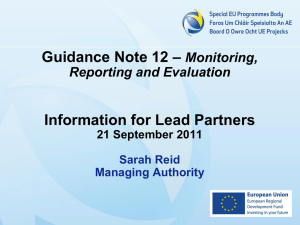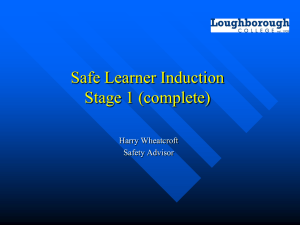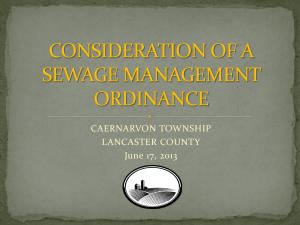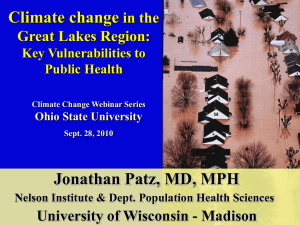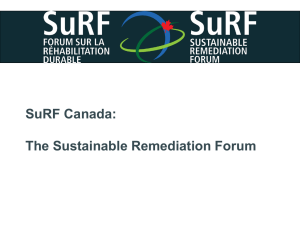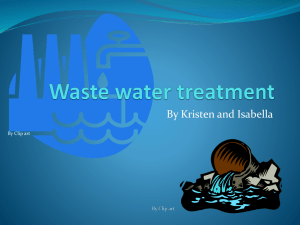Sewage Spill Response for Facilities Services
advertisement
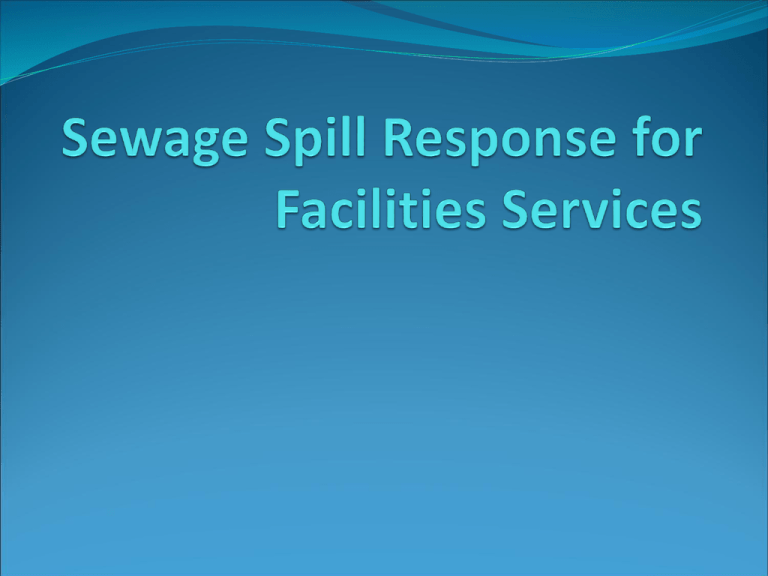
Plumbing activities Most of the body fluids directed into the sanitary system are not regulated under the OSHA Bloodborne Pathogens Standard. However, because several diseases are associated with exposure to sewage, certain employees who are involved in drain plumbing activities will be provided personal protective equipment to prevent contact with this type of material. Plumbing activities Employees who clear sanitary drain blockages with plungers are not considered occupationally-exposed to human blood or other potentially infectious materials (OPIM) unless visible blood is present in the work area or material. Workers who "snake" drains shall be considered as having the potential for occupational exposure for purposes of compliance with provisions of the Bloodborne Pathogens Standard. Appropriate PPE (gloves, eye protection, boots, etc.) shall be available to any worker clearing a blockage in sanitary drain systems. OPIM (Other Potentially Infectious Materials) Semen Vaginal secretions Synovial fluid Pleural fluid Peritoneal Fluid Saliva in dental procedures Any body fluid visibly contaminated with blood Drain Repairs (General) Flush piping with hot water prior to maintenance of drain piping, if possible. Wear appropriate gloves before breaking into the drain system. If drain traps are removed, inspect contents for human blood or OPIM and sharps. Immediately place any sharp objects (needles, razors, broken glass) into sharps containers. Handle contaminated material, especially sharps with tongs. Drain Repairs (Laboratories working with infectious microorganisms) Employees should take additional protective measures when repairing drains in laboratories where infectious microorganisms are handled (BSL2 & BSL3 labs). Confirm with laboratory personnel that any necessary decontamination has been performed prior to entry into the lab. Wear appropriate gloves and facemask or goggles/mask before starting repairs. If there is a likelihood that drain material will splash onto clothing, wear coveralls (Tyvek suit). Health Risks of Raw Sewage Hepatitis A- transmitted by ingestion, hand to mouth route; survives on surfaces for months; may cause yellowing of eyes/skin; can cause liver damage Rotavirus- transmitted through hand to mouth route, ingestion; survives on surfaces for several days; fever, diarrhea, vomiting, abdominal pain (common in children) Norwalk Virus (Norovirus, stomach flu, gastroenteritis)transmitted through hand to mouth route; ingestion; survives on surfaces for up to a week; nausea, vomiting, stomach cramps Other Health Risks? Gram Negative Bacteria- (E. coli, Salmonella) headache, fatigue, nausea Leptospirosis: a flu-like illness; persistent & severe headache, damage to liver & kidneys may occur Occupational asthma: attacks of breathlessness, chest tightness and wheezing, produced by the inhalation of living or dead organisms. Infection of the skin or eyes Rarely: inflammation of lung with fever, breathlessness, dry cough and aching muscles and joints How Do Sewage Micro-Organisms Enter the Body? Hand to mouth contact during eating, drinking and smoking Wiping the face with contaminated hands or gloves or by licking splashes from the skin Skin contact through cuts, scratches, or penetrating wounds, i.e. from discarded hypodermic needles Aerosols landing on surfaces of the eyes, nose and mouth By breathing them in, as either dust aerosol or mist Who Is At Risk? Employees involved in sewer inspection and maintenance work (unstoppage of sewer lines) Construction workers who repair or replace live sewer lines Sewer spill clean up Plumbers PPE Required For Clean Up PPE should be readily available in event of an emergency. Water-proof boots for sewage spills Coveralls for splash proofing your clothes (Tyvek suit) Utility Gloves for clean up Goggles/mask or face shield for splashes Spray Disinfectant (bleach/Coverage Plus Steris 6387-08) Sewage Cleanup Operations The cleanup and disinfection of areas that have been flooded with sewage is not considered an activity that falls under the requirements of the OSHA Bloodborne Pathogens Standard. It is recognized however, that employee exposure to raw sewage can cause illness. Employees should use the following procedures for clean- up of sewage: Staging Area Prior to clean up, a designated area outside of the contaminated area should be set up to allow employee(s) to put on necessary PPE. (PPE should readily available for quick response.) This area should remain contaminant-free, therefore individuals exiting spill area(s) should spray off boots & other contaminated PPE before re-entering staging area. Any grossly contaminated PPE (i.e. boots, gloves, etc) should be changed/discarded before exiting contaminated area. Disinfecting Area Area outside of the contaminated space should be designated for disinfecting only. Remove PPE in a manner that avoids crosscontamination. All contaminated PPE (Tyvek suit, gloves, etc.) & equipment (wet-dry vac) should be discarded or disinfected in this area. Immediately dispose of contaminated items in a plastic bag and throw them away with regular trash. Pump Truck Pump Truck Pump Truck Septic pumping trucks are specialized vehicles which combine a powerful vacuum pump with a holding tank for sewage and wastewater. The vacuum pump is activated, suction confirmed, the pumper is connected to a 4" or larger vacuum line, and the operator uses the line to clean up a sewage spill. The septic pumper operator lays out the pumping vacuum lines from the tank to the spill. The vacuum lines are not yet connected to the pumper truck nor has the vacuum pump been turned on In preparing to connect the pumper hose to the truck's transport tank, the operator must first turn on the vacuum pump. Opening the valve at the bottom of the pumper tank without first turning on the vacuum pump can permit sewage to flow back out of the tank onto the operator. Sewage Cleanup Operations If cleanup can cause splashing, wear face shields or goggles/mask. Wear gloves for all sewage cleanup. If sewage depth is greater than 1/8", wear water-proof boots. Wear Tyvek coveralls for activities that involve splashing of clothing. Remove sewage from floors and surfaces with wet-vacuums, brooms, squeegees, etc., and dispose into a functioning sanitary drain or sink. Do not dump sewage from a spill/backup onto the sidewalks. Sewage-saturated papers, books and other items must be discarded. If occupants wish to keep sewage-contaminated items, contact EHS. Sewage Cleanup Operations Watch for recognizable human blood or OPIM such as feminine hygiene products and sharps. Place any sharp objects (needles, razors, broken glass) into sharps containers and other objects (bandages) into disposal bags. Use tongs, pieces of cardboard or other mechanical means to pick up sharp objects. Keep sharps containers closed except when placing materials inside. Sharps containers must be puncture-resistant, labeled or color coded as biohazardous material, and leakproof on the sides and bottom. (EHS can provide) After vacuuming up the material, apply a bleach solution or Coverage Plus Steris 6387-08 to all surfaces that came in contact with the sewage. Hard surfaces should be wiped clean and left to dry following application of the disinfectant. Sewage Cleanup Operations If the spill site is large use a 10% bleach solution or Coverage Plus for disinfection. The bleach solution should be prepared by mixing 1 part household bleach with 9 parts water. Bleach solutions should not be used to disinfect fabrics such as carpets, and should be used within 24 hours of preparation. Remove sewage materials from soft or porous surfaces (carpets, office partitions, etc.) with wet-vacuums, carpetcleaners, steam-cleaners, etc. An appropriate disinfectant should then be applied to these surfaces and allowed to air-dry. Disinfect reusable equipment with disinfectant prior to removal from the site. Following Sewage Spill Cleanup Properly remove & discard PPE (gloves should be removed in a manner to avoid cross contamination) in disinfecting area outside area that was contaminated with sewage. Wash hands thoroughly. If a sink is not available use hand sanitizer until you are able to properly wash your hands with soap and water. If you have any questions regarding clean up procedures please contact the Biological Safety Section at EHS 919-962-5507. Flood Response Area Designations Secure contaminated area against unauthorized entry. Designate ‘Staging Area’ outside of contaminated space for donning PPE. Set-up ‘Disinfecting Area’ equipped with plastic bags and disinfectant outside of contaminated space SEWAGE CONTAMINATED AREA “Clear Water Event” Events involving parts of the wastewater stream including, but not limited to, surface water, ground water, condensate, roof leaks, steam leaks, potable water leaks, and/or discharge from swimming pools and water treatment devices. Recommended PPE: Gloves Booties/Waterproof Boots Eye Protection (if there is a splash risk) “Black/Gray Water Event” Events involving fractions of the wastewater stream that originates from sewage, dishwashers, showers, washing machines and food preparation sinks. Recommended PPE: Gloves Tyvek suit (if there is a splash risk) Waterproof Boots Goggles/mask or face shield (if there is a splash risk) Buildings with Special PPE Considerations Berryhill and Fetzer Hall: House laboratories that contain formalin-treated cadavers. The Chemical Safety Section at EHS (962-5507) should be contacted prior to the cleanup of water events in this building. Brinkhous-Bullitt Building Hospital Morgue (11th Floor): Houses areas containing untreated cadavers and organs. PPE for the cleanup of these areas will be consistent with that of a “clear water event” unless: Visible blood or other potentially infectious materials (OPIM) are present. PPE consistent with a “black water event” is recommended Water is suspected to contain hazardous chemicals. Contact Chemical Safety at EHS prior to cleanup. Call Biological Safety pager (919-216-3963) prior to ‘after hours’ cleanup .
